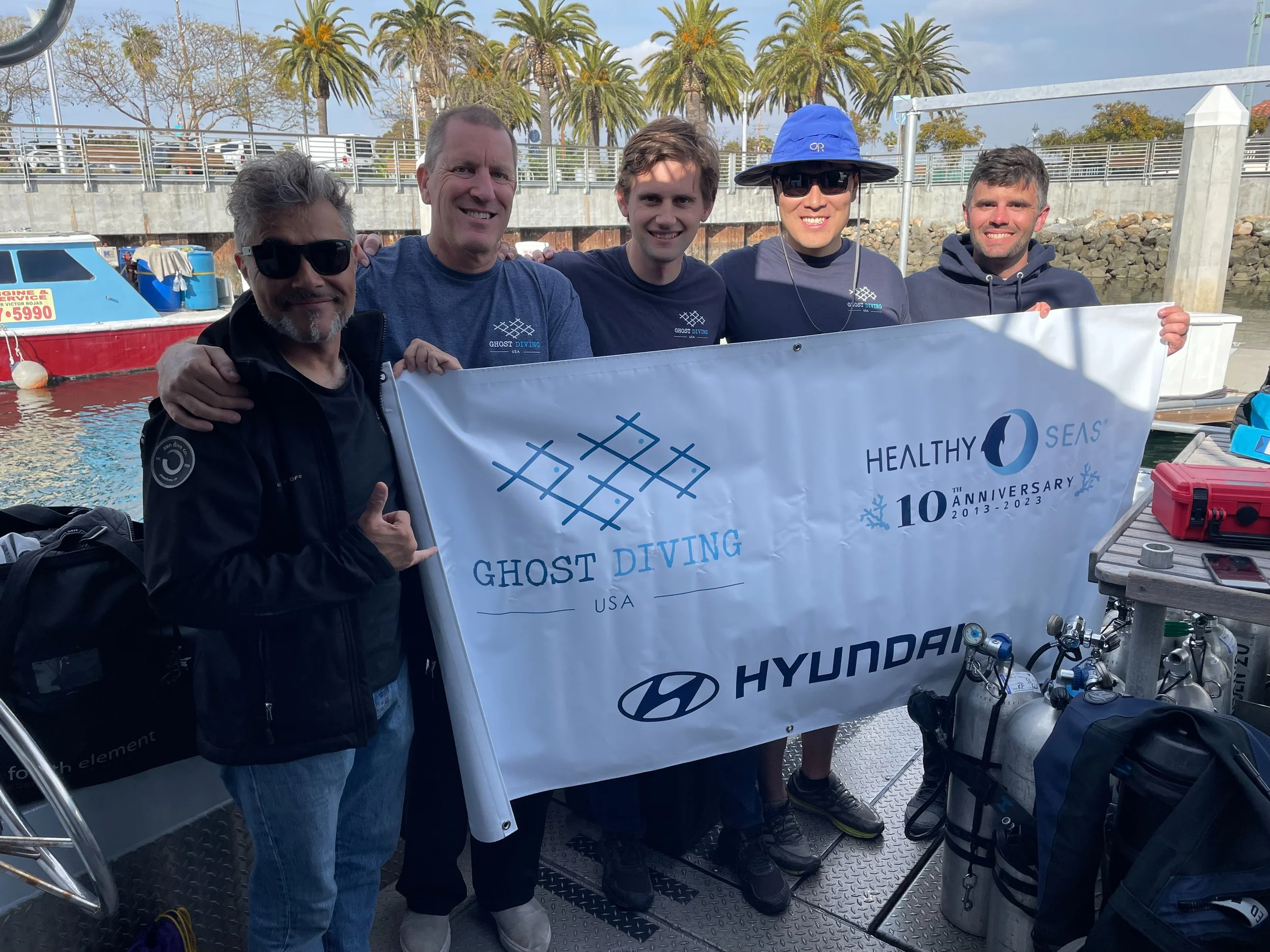Pasadena Science Fest
Location: John Muir High School, Pasadena
Team Members: Katie McWilliams, Shane McWilliams, Mark Self, Yury Velikanau, Walter Zagzebski
Healthy Seas Ambassador: Julie Encinas
Team Ghost Diving USA was thrilled to be invited back to the Pasadena Science Fest at John Muir High School! Science Fest is hosted by the Pasadena Unified School District and is an opportunity for the community to connect with various STEM career professionals and science-related volunteer and career opportunities. We were fortunate to have a volunteer from our sponsor, Healthy Seas, Julie. Together we talked to people about our mission and how, through Ghost Diving’s partnership with Healthy Seas, abandoned and recovered fishing gear can be given new life and purpose away from the ocean.
In talking to people at the event, it was fun to hear their experiences and their feelings about the ocean. We offered coloring pages, a game for kids to rescue animals out of the net, pictures, and videos from our missions. Visitors asked a lot of questions about how deep our missions were, what kinds of life we saw at depth, and what types of legislative measures were in place to address the issue of ghost gear. Our team was received warmly by the Science Fest attendees. We were encouraged to hear that many of the visitors were already taking steps to be more conscious consumers.
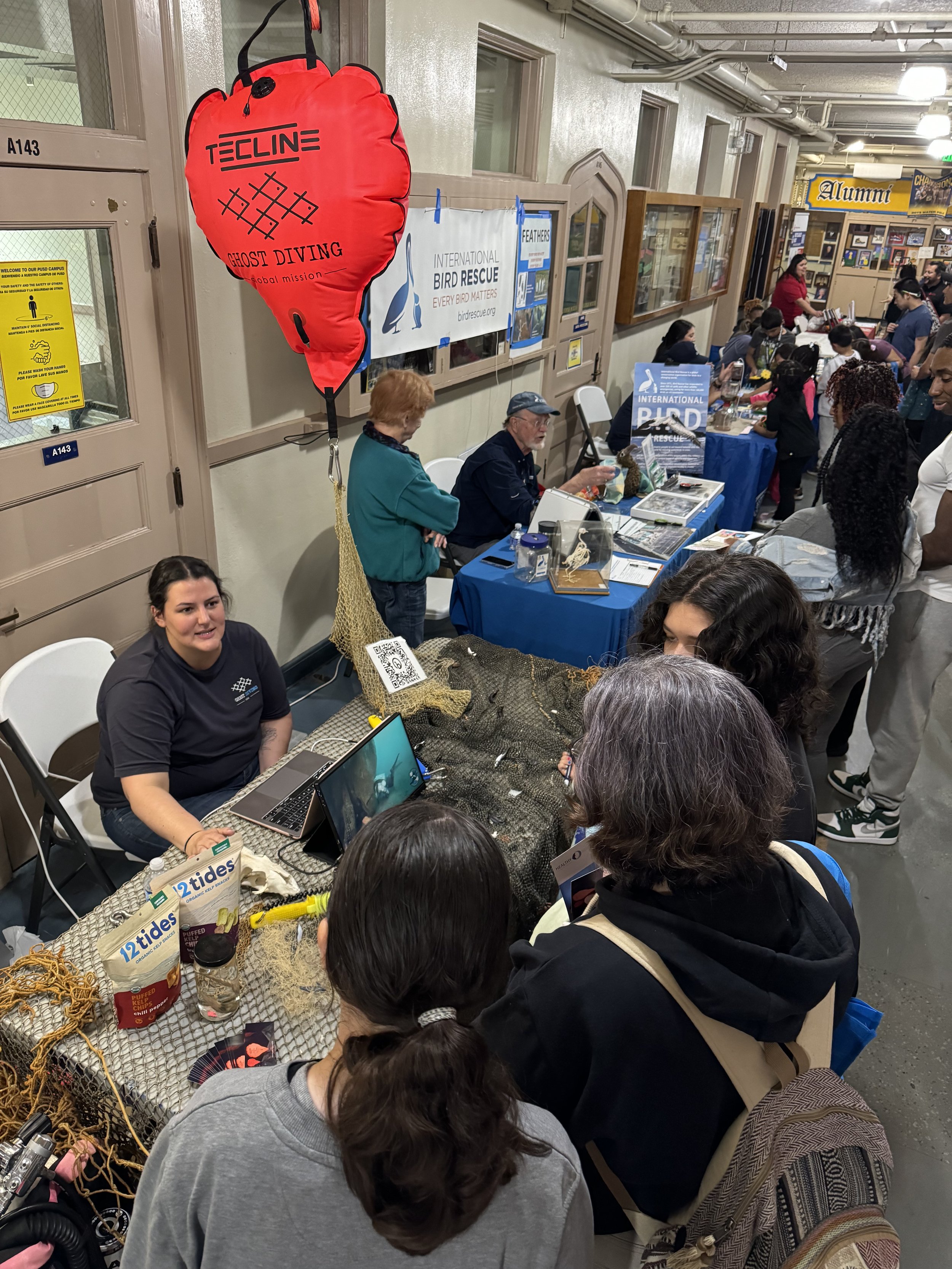

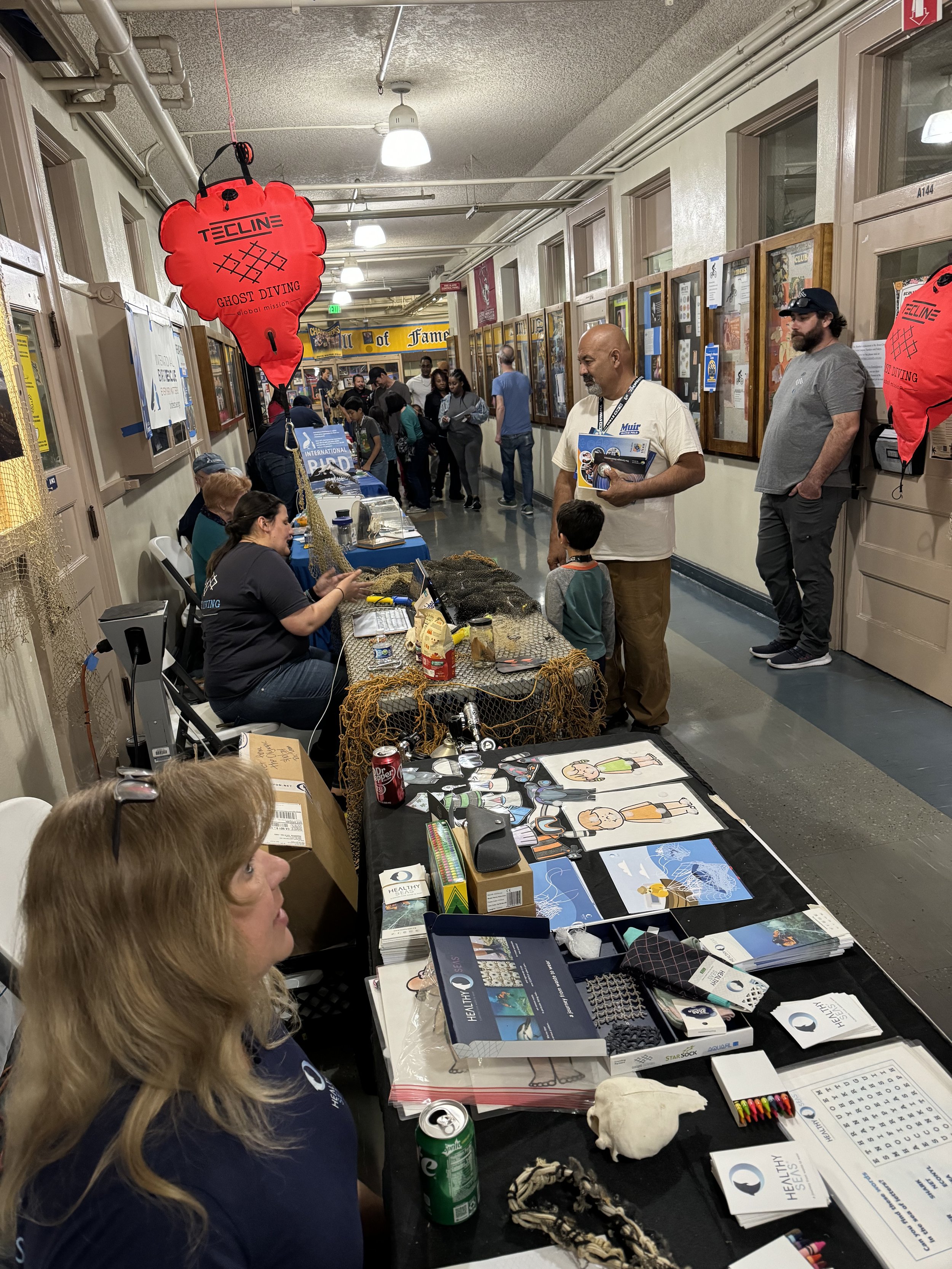






We would like to give a special thank you to the Pasadena Science Fest committee and especially Warren Skidmore for inviting us back and ensuring the day ran smoothly.
The Olympic
Location: San Pedro, California
Wreck/Site: The Olympic
Divers: Angie Biggs, Sean Canullas, Katie McWilliams, Shane McWilliams, Daniel Pio, Rene Tetter
Dive 1
Teams:
Net Handling Team: Katie McWilliams, Shane McWilliams, Rene Tetter
Documentation/Observation: Angie Biggs, Sean Canullas, Daniel Pio
Mission Impact: 50 square feet of net and 1 large piece of plastic recovered
The GDUSA recreational team set out for a day of mentorship and net removal aboard the Giant Stride. Headed for the Olympic, the team was gifted ideal surface conditions. The sun was shining, there was no wind or swell. The team was able to comfortably prepare for their dives while on the crossing to the dive site. The team opted to complete 2 dives. On the first dive, the objective was to locate the net described by previous team member observations. After locating the net, the team planned to set lift bags and, if bottom time and breathing gas allowed, start cutting the net. The team was extremely efficient with their time, met all of their objects and were able to launch their first lift bag at the end of dive 1. The team returned to the boat, completed a debrief, had some 12tides kelp snacks, and planned dive 2. While the teams were planning dive 2, we observed some debris floating on the surface. Rene was able to recover a large piece of plastic that appeared to be part of a broken plastic bin.
Dive 2
Teams:
Inflation/Documentation: Shane McWilliams, Daniel Pio
Net Handling Team 1: Angie Biggs, Katie McWilliams
Net Handling Team 2: Sean Canullas, Rene Tetter
For dive 2, the teams broke into 3 teams of 2. The net handling teams worked on 2 sections of net. Both net handling teams were able to remove their sections of net and attach the lift bags. Shane shot both lift bags to the surface. Dive 2 went extremely well! For the team members that were starting their mentorship process, they had the opportunity to get hands on experience and the team worked cohesively to support each other. The teams got back onto the boat and worked with Captain Jim to pick up the lift bags and return to port. The net collected from this mission was kept for displays during our outreach events.
UB-88
Location: San Pedro, California
Wreck: The UB-88
Team
Documentation: Jim Babor, Tianyi Lu, Curtis Wolfslau
Mission Impact: More photos for the photogrammetry model collected, model is nearing completion
Team Ghost Diving USA set out to continue their reconnaissance of the UB-88. The team shared their time aboard the Giant Stride with a Tech 2 class. Excitingly, the Tech 2 was full of familiar faces to include 2 team members, Kian and Mike, and was taught by our Vice President, Karim. We love to see our team members advance their training and education because it is representative of their commitment to their personal growth and development and honing their craft.
For the rest of the team members Jim, Curtis, and Tianyi, the mission was focused on documentation and gathering more photos for the photogrammetry model. After discussing, the team planned for a maximum of 40 minutes at depth with a goal of spending 30 minutes at depth. Their goal was to photograph the net that is on the wreck from its attachment point on the stern to the top of the conning tower. Tianyi was assigned the port side of the wreck, Curtis the starboard side, and Jim was the third teammate and observer. Additionally, Jim was testing a new housing for a GoPro that has a deeper depth rating. Jim previously found that the pressure at depth rendered the buttons on the previous housing inoperable.
The mission ran smoothly for the team of 3! All their objectives were met. Using the images collected during the mission, Curtis was able to make significant progress on our photogrammetry model. While the model is nearing completion, the team would like to dedicate one more dive to the photogrammetry model to fill in any holes and cover the conning tower and the torpedo tubes.
The UB-88 will be a labor of love for team Ghost Diving USA but we love a challenge!
UB-88
Location: San Pedro, California
Wreck: The UB-88
Teams:
Team 1 - Symeon Manias & Curtis Wolfslau
Team 2 - Jim Babor & Karim Hamza
Surface Support: Mike Schlegel
Mission Impact: Photos and videos collected for mission planning phase and photogrammetry model started.
Team Ghost Diving USA set off on the first on many missions to the UB-88. This is an exciting project for the team! The UB-88 is one of the more unique offerings in Southern California diving. For this mission, the primary objective was to gather documentation of the nets that are currently on the wreck and begin the photogrammetry modeling process. The teams were able to meet both of these objectives!
Symeon and Curtis focused on collecting images to create a photogrammetry model. Jim and Karim focused on collecting photos of the nets and how they are attached to the wreck. the purpose of these images to allow the team to precisely plan how they will address each part of the net and determine how they want to prioritize the different areas of net.
The history of the UB-88 is rich and presents Ghost Diving USA with a unique opportunity to help preserve the history of this historic site.
The UB-88 was originally built during World War 1, specifically, in February 1917 in Hamburg, Germany. UB-88 was commissioned by the Imperial German Navy on January 26, 1918 with Oberleutnant (Lieutenant) Johannes Ries at the helm. After initial testing was completed, Kapitänleutnant (Lieutenant Captain) Reinhard Von Rabenau was placed in command. Kapitänleutnant Von Rabenau had a lengthy resume of successful missions on the UC-77.
Once Von Rabenau took command of the submarine, the UB-88 was assigned to the First Submarine Flotilla, Flanders. On June 10, 1918, the UB-88 encountered 5 British freighters, 6 trawlers, 2 destroyers, and 2 aircraft. She successfully sank the British steamer the Princess Maud (Cressman & Mann, 2021). This would be the first of many scrimmages that would prove UB-88 victorious. Over the course of her summer 1918 tour, UB-88 would encounter a number of vessels or fleets. She would ultimately claim the lives of at least 83 men and an unknown (but extensive) amount of cargo.
On October 3, 1918, she was reassigned to the Second Submarine Fleet, High Seas Fleet and remained inactive through the end of World War 1. On November 11, 1918, the UB-88 alongside the High Seas Fleet, surrendered when the armistice ended the conflict. UB-88, along with other vessels, was acquired by the US Navy on March 23, 1919 with the acquisition being advertised in conjunction with a Victory Bond drive. the agreement was that the U-boat was to be destroyed at the conclusion of the bond campaign.
She arrived in New York on April 27, 1919. After some final work was completed, UB-88 set out on a tour of the Gulf Coast, the Mississippi River, the coast of Mexico, the California coast and the Pacific Northwest. UB-88 left New York on May 5, 1919 and initially arrived in San Diego, California on August 29, 1919. She returned to San Pedro, California on November 7. After being laid up for 4 months, the work to dismantle her began on April 1, 1920. After she was decommissioned on November 1, 1920, she was sunk by a wickes destroyer’s gunfire on March 1, 1921.
Bluff Point
Location: Rancho Palos Verdes
Site: Bluff Point
Teams:
Team 1 - Katie & Shane McWilliams
Team 2 - Keith Chu & Norbert Lee
Team 3 - Angie Biggs & Jung-han Hsieh
Surface Support: Juan Torres
Mission Impact: No metrics.
Despite recent storms, the team opted to give a mission a try. With variable sea conditions following a large storm, the team was unsure of what conditions below the surface were going to be. Captain Jim of the Giant Stride greenlit the team heading out. Surface conditions were chilly but the water was calm and the sun came out to greet the team. The team was provided a briefing of the site, agreed upon a plan, and were committed to executing the plan.
The goal of this mission was to give the recreational team some mentorship time and hands on experience with net. Armed with scooters and a plan, the teams set out. Once the teams arrived at their target location, they geared up and jumped in. As they descended, conditions fell apart fairly rapidly. The teams descended down the anchor line. The visibility in the first 30 feet of water was decent, the light was penetrating the water column. At 40 feet, darkness crept up into the water column like ink. As the divers descended to 50 feet, the visibility went to virtually zero. The water became a dense green. As divers continued to descend to the bottom at 60 feet, they were unable to see the sand. The visibility was completely gone. The divers were in the position of having to feel their way around.
The mission became extremely complicated at this point. The 6 divers were broken down into 3 teams of 2. The purpose of dividing the teams this way was to make it easier for the divers to stay together. By only being focused on staying with 1 person, rather than 5 others, the divers can easily balance both looking for the net and staying with their partner. Unfortunately, 1 team of 2 became separated from the group due to poor visibility. More unfortunately, the other 2 teams did not see that the third team had remained at the anchorline. The other 2 teams were able to stay together and started to search for the net due west. After approximately 8 minutes of searching, the teams decided it would be better to abort their efforts and return to the surface. Once the teams surfaced, they were reunited with the third team and returned to the boat.
While it could be easy to call this mission a loss because there was no net or any other debris recovered, it’s more important to focus on the wins because there were plenty! First, the teams came back to the boat safely. While this seems a bit obvious, it is the most significant of the wins. Conditions like those encountered by our divers can and have led to catastrophic accidents. Our divers were able to maintain their composure and work together to not only try to complete the mission but they were able to recognize when it was time to make a decision based on safety. At the end of the day, this mission was a win because all of the divers, individually and collectively, reverted to their rigorous training. They received the dividends of their earlier investment. Not only were they able to problem solve individually but they were able to build a functional unit that was able to navigate a challenge.
While not every mission can result in the typical win, every mission is a lesson. This mission taught our recreational team that any dive can escalate to extremely challenging in a matter of seconds. Our divers must remain vigilant and prepared. They must commit themselves to honing their craft and furthering their education. They must always strive to be their best selves for themselves, the team and the mission.
The Jenny Lynne
Location: Rancho Palos Verdes
Wreck/Site: The Jenny Lynne
Teams:
Team 1 (Net Handling): Karim Hamza & Shane McWilliams
Team 2 (Scientific Sampling/Net Handling): Michael Gasbarro & Norbert Lee
Team 3 (Photogrammetry/Documentation): Kian Farin & Daniel Pio
Surface Support: Katie McWilliams
Mission Impact: 350 square feet of net recovered, scientific samples collected, photos taken for photogrammetry model
Ghost Divers returned to the wreck of the Jenny Lynne. There were 3 objectives for the day:
To collect net and water samples for on going research at UCSB
Next, to collect images for a photogrammetry model
And as always, remove remaining nets on the wreck
The divers worked diligently and efficiently to achieve all 3 objectives! Karim and Shane focused their net removal efforts on the mast while Michael and Norbert focused on the bow and anchor. After completing their first dive, divers enjoyed a 90 minute surface interval and some delicious kelp snacks provided by our partner, 12 Tides.
As the divers diligently worked on the second dive, lift bags raced to the surface. Each lift bag represents more net removed from the wreck. Once the divers remove the net, finish their decompression obligation and get back onto the boat, they work together to bring the net onto the deck of the boat. They discovered that they recovered 350 square feet of net. Ghost diving is hard work but Ghost Diving USA always finds the fun! We will have to return to the Jenny Lynne but there is a significant progress and we are excited to see the wreck clean.
GDUSA x Hyundai Motor America Beach Clean Up
Ghost Diving USA, as a non-profit organization, is reliant upon donations to continue and further our work. Recently, Hyundai Motor America joined the network of organizations that support us in our missions. To celebrate our newly forged partnership, we participated in a joint beach clean up.
With support from Orange County Coastkeeper, Ghost Diving USA and Hyundai Motor America team members arrived at Huntington Beach Lifeguard Tower 9 to clean up the beach. Participants were greeted by a beautiful fall day. The sun shined brightly, there was a light breeze while the waves crashed upon the shoreline.
Photo credit: Curtis Wolfslau
The day started with a briefing. Jim, the president and CEO of Ghost Diving USA, discussed the impacts of our missions to that point and the importance of our partnerships. Ellie, a Healthy Seas representative, discussed sustainable consumerism and the empowerment of consumers to be sustainable. She explained how crucial the partnership with Hyundai Motor America is in taking another step forward in creating a circular economy.
After a safety briefing given by Ives from Orange County Coastkeeper, the volunteers got to work. While the beach at an initial glance appeared to be clean, volunteers quickly learned that the problem of beach trash and microplastics can hide in plain sight.








After an hour of cleaning the beach, our teams managed to remove 57.71 pounds of trash from the beach! Attendees enjoyed a lunch mixer after their hard work cleaning the beach.
As a team, Ghost Diving USA is grateful to Hyundai Motor America for their support for our cause. We look forward to a bright future together!
The Tuna Clipper
Location: Catalina Island
Wreck/Site: The Tuna Clipper
Teams:
Team 1 (Net Handling): Jim Babor & Karim Hamza
Team 2 (Net Handling): Michael Gasbarro & Norbert Lee
Team 3 (Photogrammetry Team): Tianyi Lio & Curtis Wolfslau
Surface Support: Quinn Shin
Mission Impact: 1,000 square feet of net recovered, photos collected for photogrammetry
Our team returned to the wreck of The Tuna Clipper to remove more nets and continue to collect photos for the photogrammetry model of the wreck. While the divers were focused on their mission, their mission was not without challenge.
The conditions were rough. Aboard the Giant Stride, the team ventured into 5 foot swells at 10 second intervals. This means that every 10 seconds they experienced a 5 foot wave, making for a bumpy ride and seasick divers.
Jim and Karim descended first and staged lift bags for Michael & Norbert. The net handling teams teams were able to recover 1,000 square feet of net that was taken to Aquafil for repurposing. The photogrammetry team continues to collect images to complete our model. Their focus for this mission was to collect images in targeted areas that required refining.
Overall, the team is making good progress on the Tuna Clipper and continues to maintain its focus on the outcome of cleaning and appropriately documenting the collection of net at this site.
Krnica, Croatia
In April of this year, I was invited to take part in the Healthy Seas 10th anniversary as Ghost Diving USA’s President which I happily accepted. After much planning leading up to the September event, a quick 13 hour flight to Istanbul, a five hour layover, a two hour flight to Ljubljana , and finally a two hour drive to Krnica, Croatia, I arrived the night before the event was to start.
The six day event consisted of team leaders from 12 different countries all there to celebrate 10 years of Healthy Seas and at the same time take part in five days of debris recovery in the the area. Each day consisted of one dive with specific areas and goals in mind. We would run on two boats with the teams were split accordingly. One of our main objectives during these cleanups was the recovery of gillnets. I was shocked at the amount of gillnets that I saw, and just how destructive these nets are. Within 5 minutes of the very first dive for the event we encountered numerous crabs and lobster that were entangled but still alive in the gillnets. We were able to free everything we saw, but it emphasised just how destructive these nets are. I have not encountered these here in the United States. I was shocked at how many live animals we saw in the nets in the short amount of time we were there and how many we were able to release each day. I am happy to report that we were able to finish our goals and recover hundreds of pounds of debris, nets, lobster pots and various bits of garbage.
Krnica is a very small rural town on the east coast of the Istrian peninsula in Croatia. It is beautiful and picturesque. Each night was spent in a local restaurant in Krnica that had great Italian food. Since the moment I arrived I was greeting warmly by the Healthy Seas representatives and all of the team leaders from the other countries. English was the preferred language (thank goodness!). Being able to talk with leaders from the other chapters was extremely educational for me. I learned a lot of recovery techniques. Other teams use different techniques because of the various conditions the teams are diving in. We were also able to discuss the logistics of how they run their chapters.
On the final day, all of the teams, donors, and representatives drove up to Ljubljana, Slovenia and took factory tours of Econyl and Aquafil. This was quite an experience for me. I had never seen the upcycling process in person and now I’m able to bring that experience back and educate people in our presentations and outreach events on how the net is processed and repurposed. Seeing the warehouse filled with 60 tons of net that turns over every 30 days also hit home and highlighted how big the problem is, but also how beneficial the partnership with Econyl and Aquafil is to us.
Finally, once the event was finished, I returned to Krnica for 2 extra days of some fun Tech 2 wreck dives with a new friend from Ghost Diving UK.
My take away from this experience is that we are everywhere, just like the slogan says: “ghost fishing gear is everywhere, but so are we”. There are chapters all over the world and everybody that I met is just as passionate as we are about problem and the solution. I dove with almost everybody at the event at different times, and everybody is exceptional in the water. Standardization of underwater communication, cleanup procedures, gases, and equipment made logistics and dives easy and efficient.
I’d like to give a huge thank you to Krnica Dive and Maurizio Gurbach for providing everything for us, and making everything so easy for us during our stay.
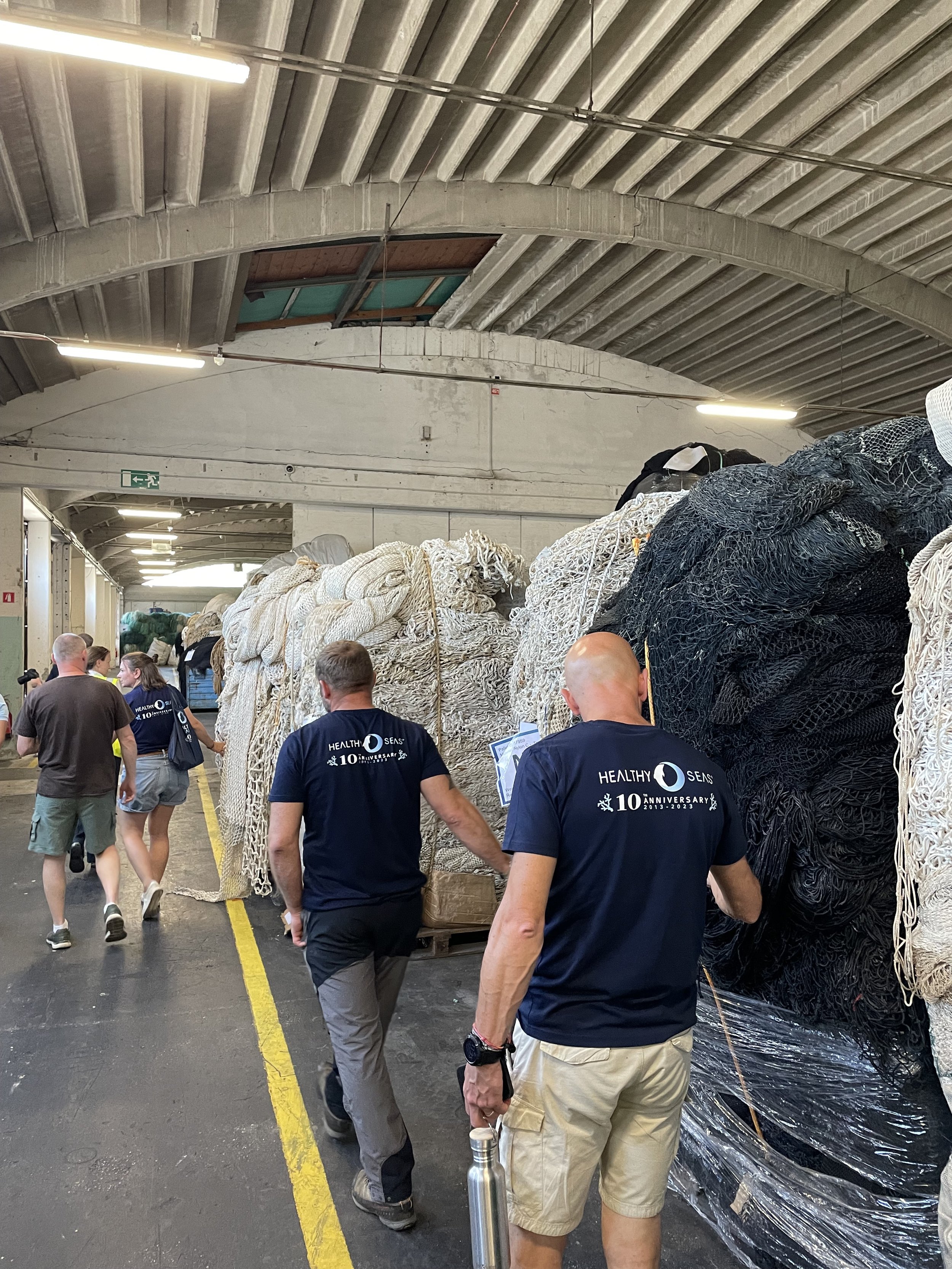
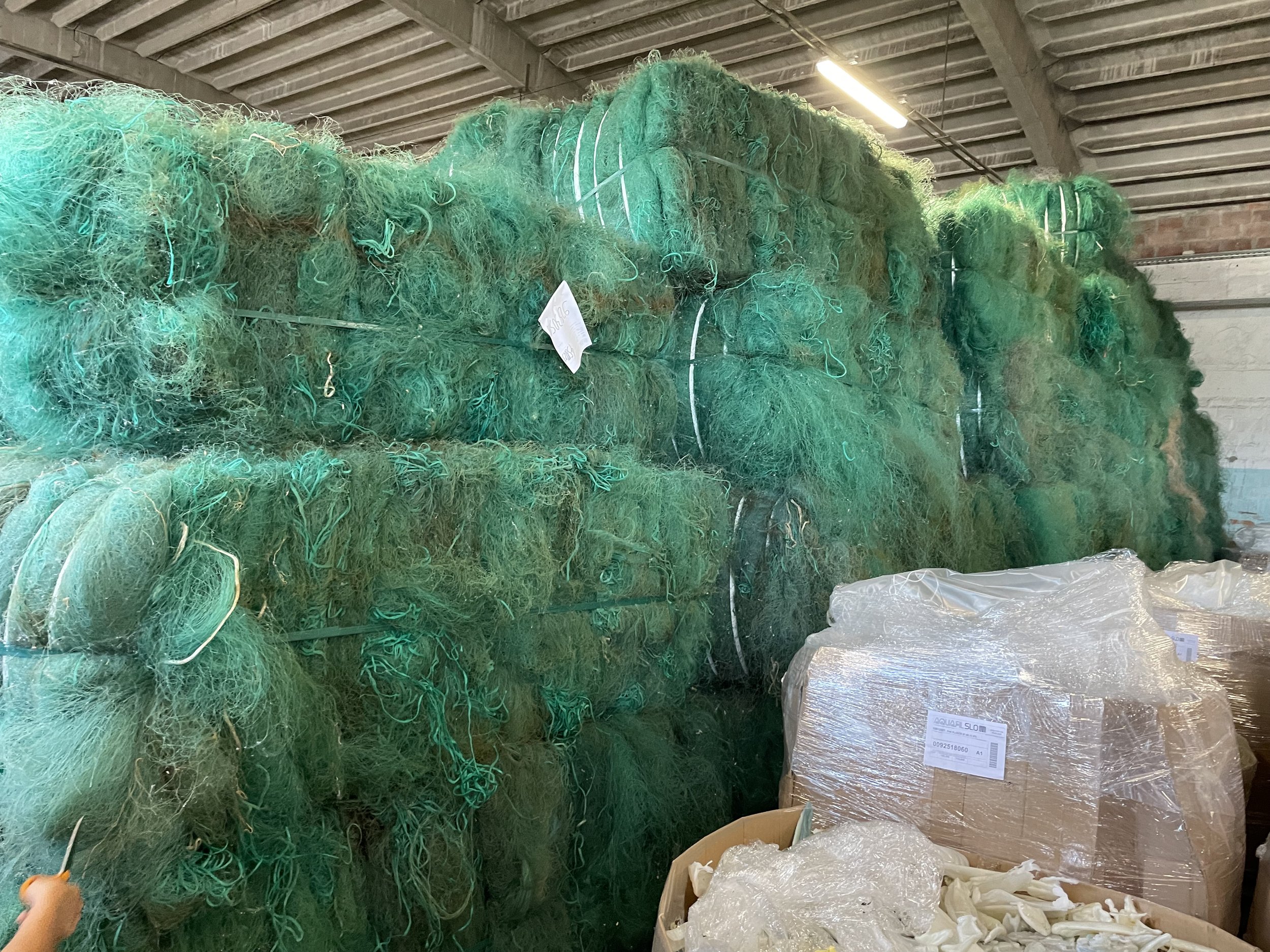



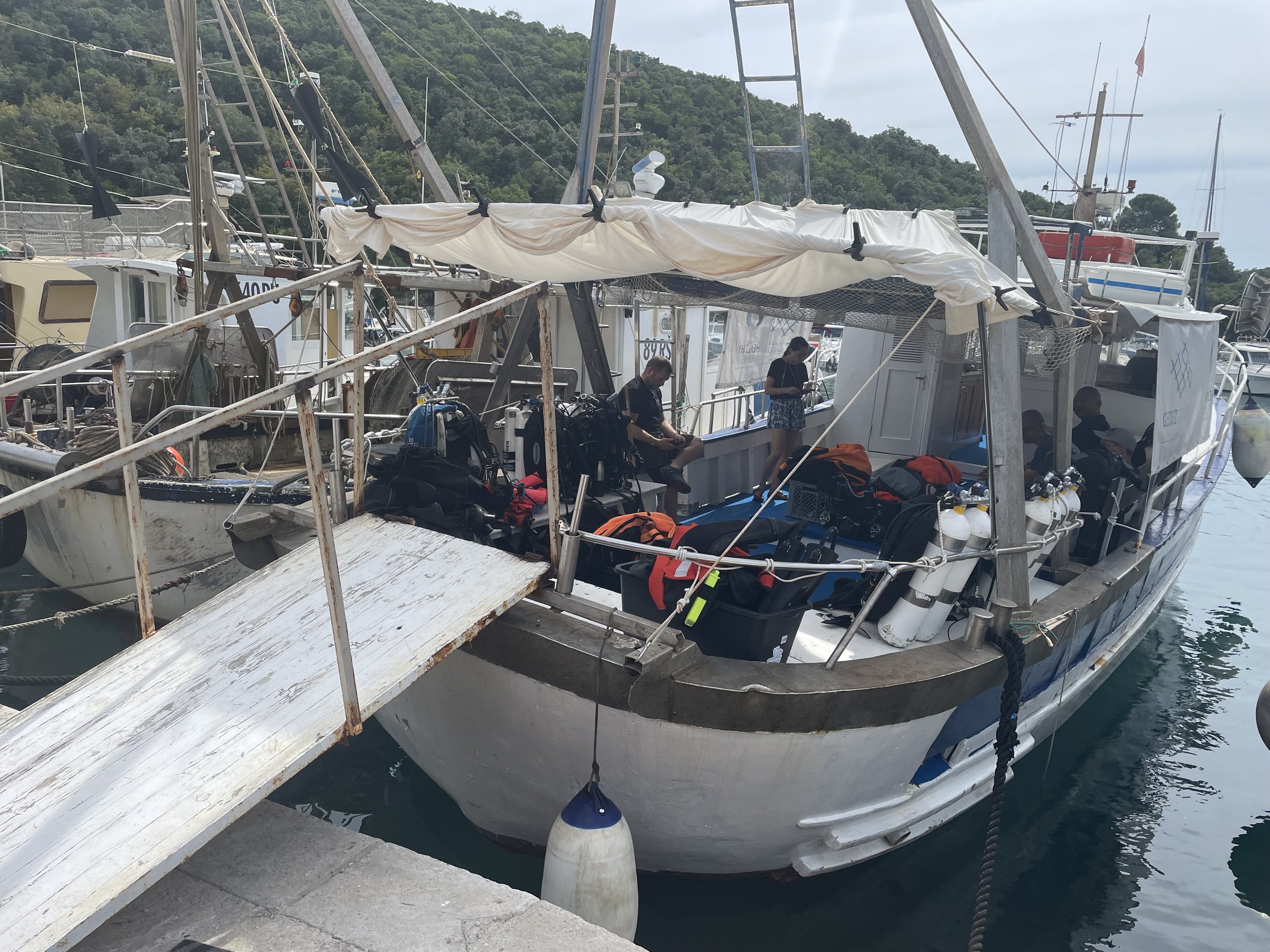
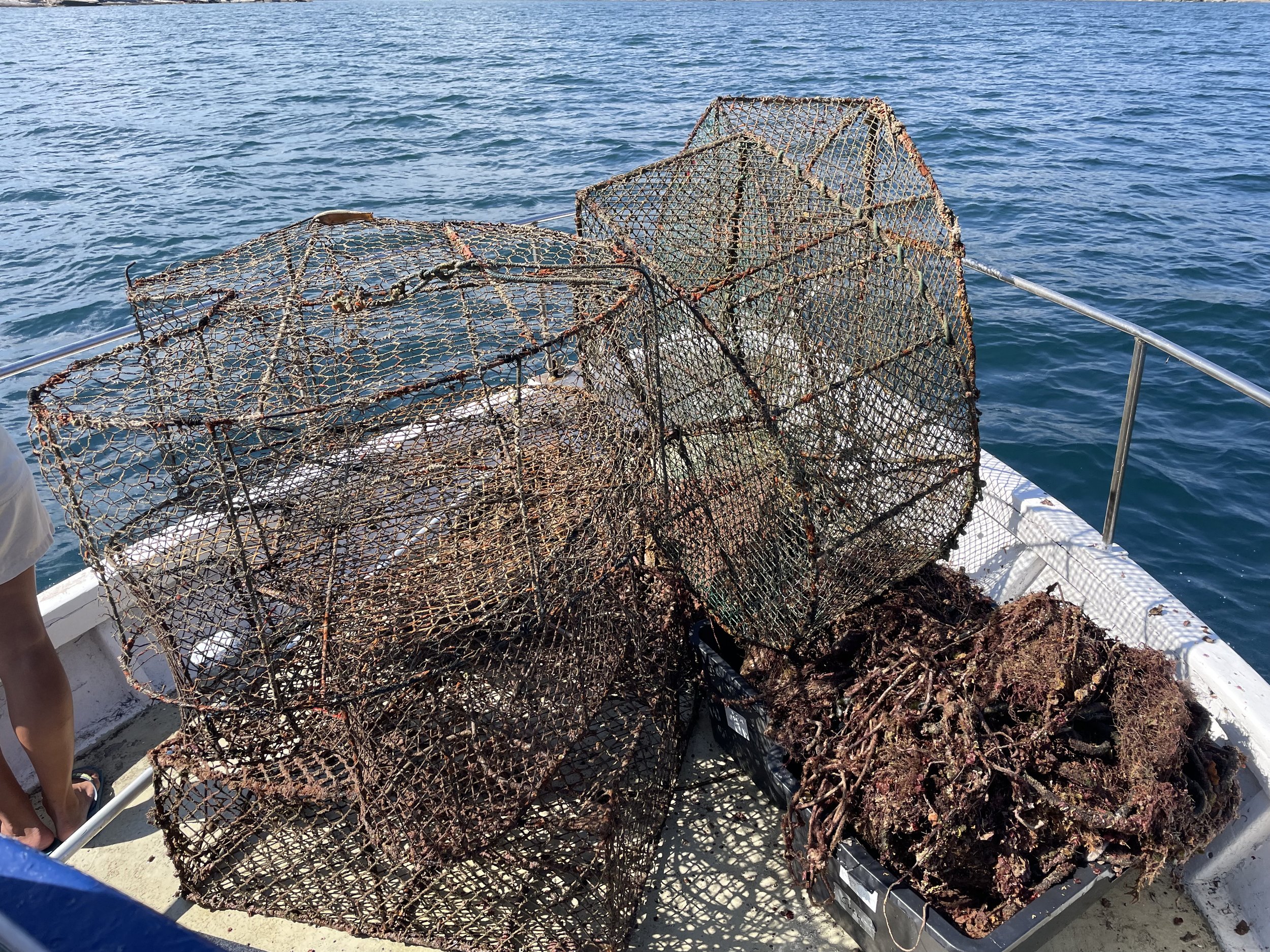

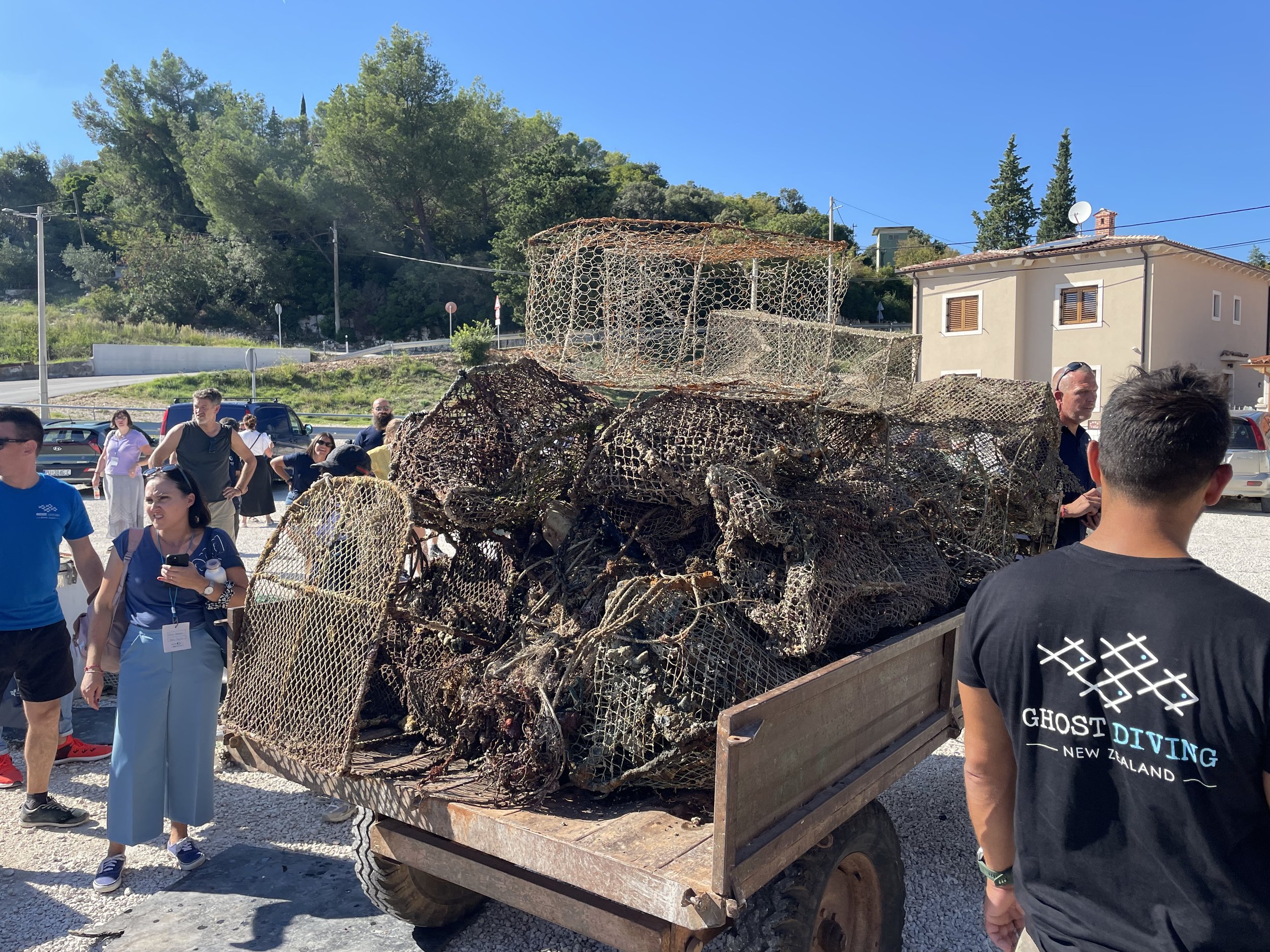
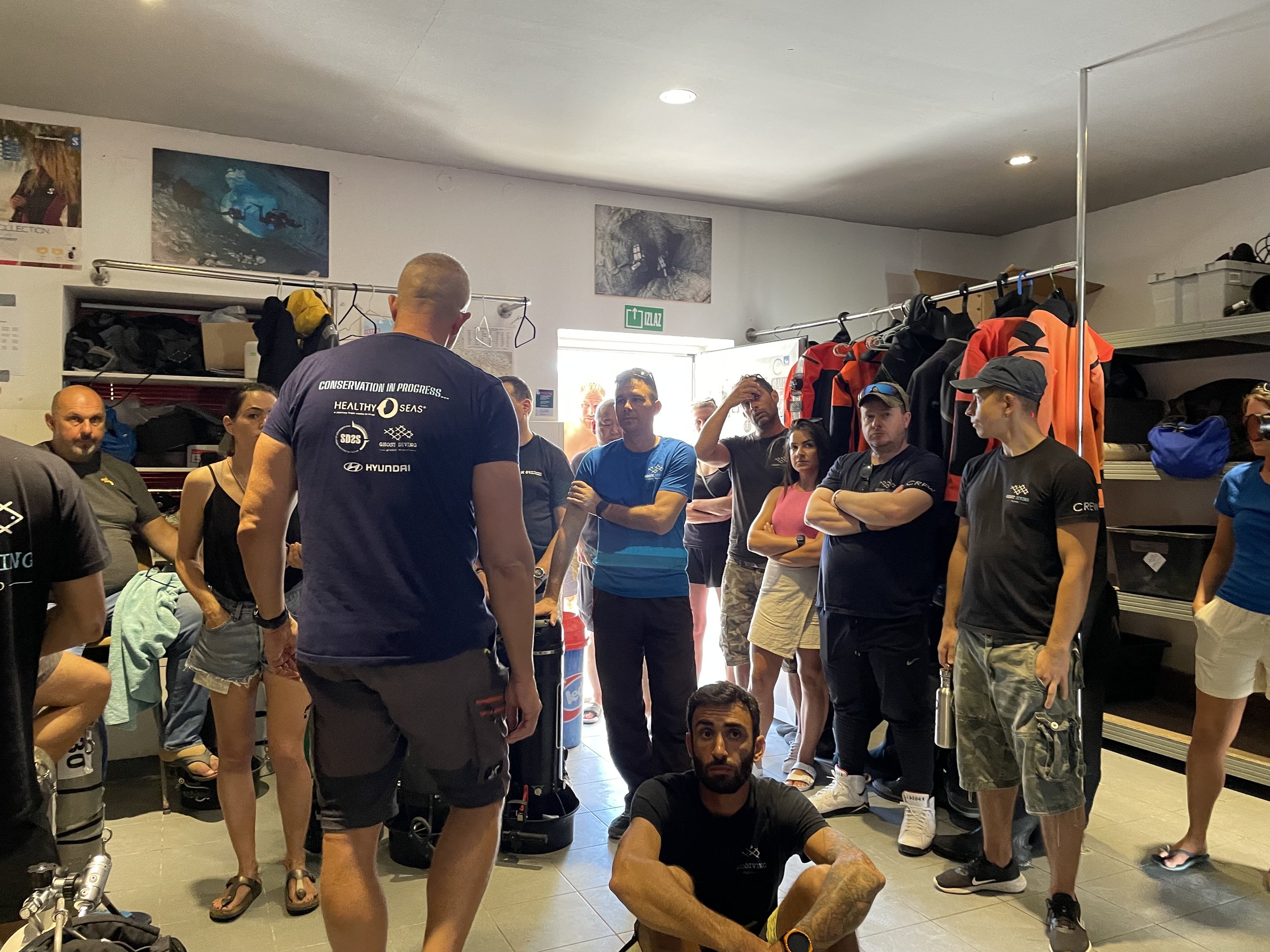
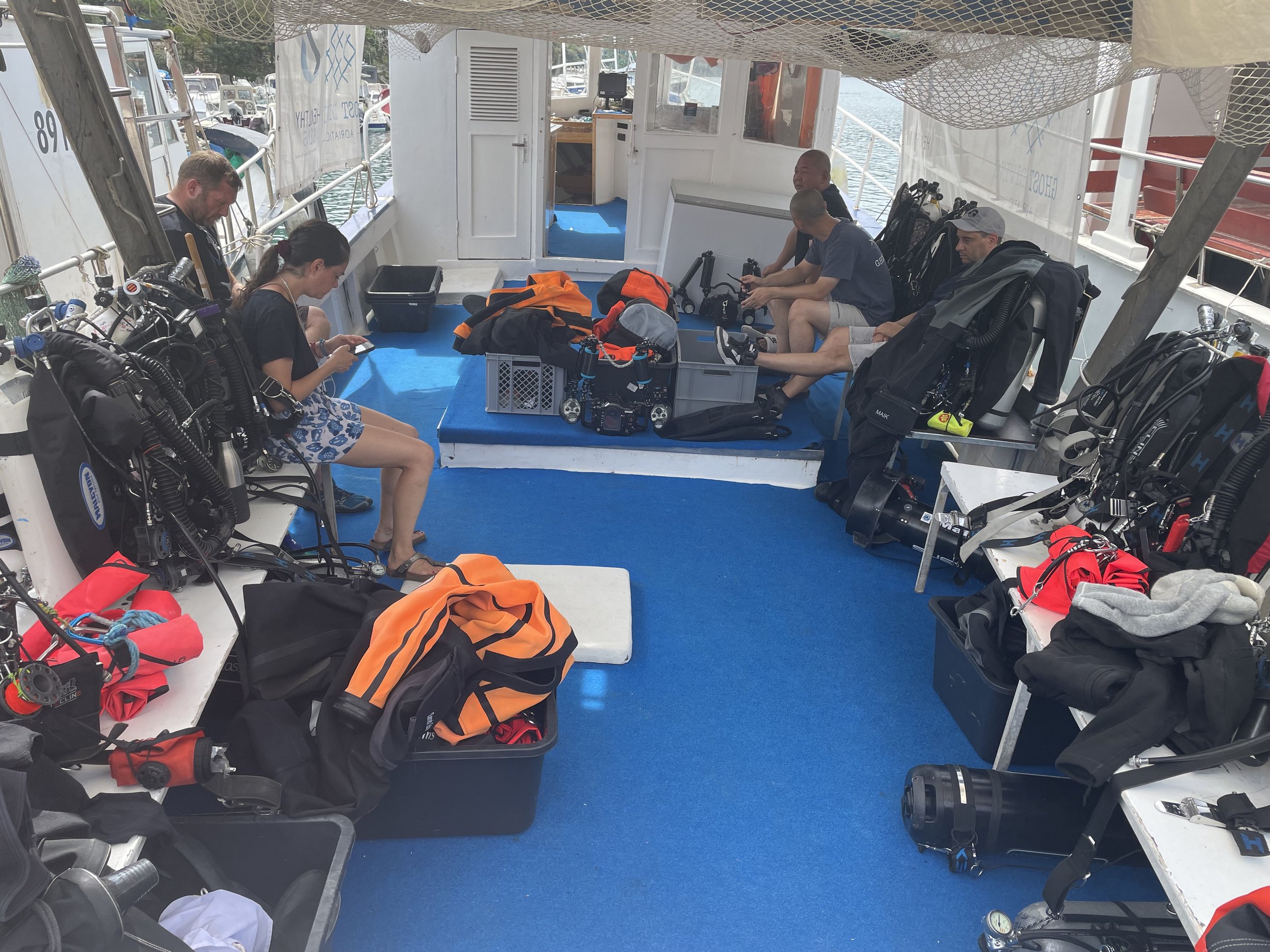
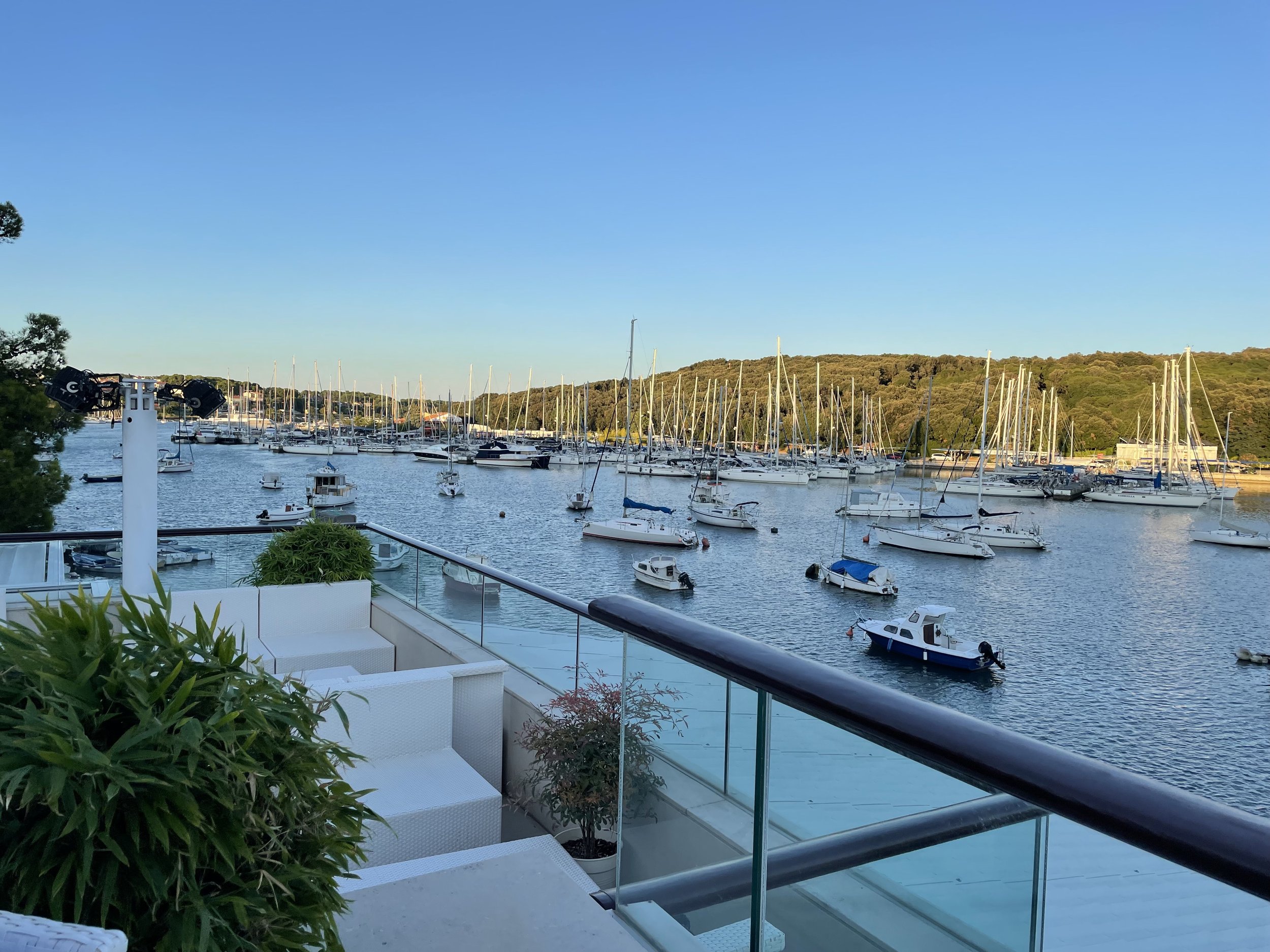
The Tuna Clipper
Location: Catalina Island, California
Wreck/Site: The Tuna Clipper
Teams:
Team 1 (Net Handling): Jim Babor, Karim Hamza
Team 2 (Photogrammetry Team): Shane McWilliams, Daniel Pio, Curtis Wolfslau
Surface Support: Mike Schlegel, Juan Torres
Mission Impact: 300 square feet of net recovered, 1,500+ images collected
Ghost gear always presents unique challenges to our divers. Our goal remains the same, to clean up the ocean and document our work to educate others. Our team took our documentation to a new level with the use of photogrammetry. Photogrammetry, as defined by the American Society for Photogrammetry and Remote Sensing (ASPRS) is the “art, science, and technology of obtaining reliable information about physical objects and the environment, through the processes of recording, measuring, and interpreting imagery and digital representations of energy patterns derived from noncontact sensor systems”. Over the course of 40 minutes (2 20-minute dives to 170 feet), Daniel and Curtis were able to take approximately 1,500 images. These images are taken in painstaking detail. Each photo is taken within 3 feet of the object and from every angle of the object. These images will then be run through software that will stitch the images together to build a 3D model of the object. If our divers miss any detail, it will be missing from the rendering. Photogrammetry is a work of precision and patience. Our team estimates that with another 60-70 minutes of time at depth, they should be able to finish collecting photos of the wreck.
Jim and Karim set out to continue removing net from the wreck and were able to successfully remove 300 square feet of net. Of the unique challenges presented on this dive, they had to be mindful of the visibility for the photographers. They needed to stay down current of the photogrammetry team. Next, they continued their work on sections of net that were buried in the sand. This is always challenging because they must be mindful of where they are in relation to the net when lifting it. It is easy to become entangled in the net that lifts off the sand because of the reduction in visibility.
Team Ghost Diving USA continues to find new and innovative ways to share our work and our mission with the public. We look forward to incorporating technology to help make our work more tangible to the public. These 3D models will show the nets on the wreck. As the clean-up process continues, our divers get to feel the satisfaction of cleaning the ocean and unwrapping these wrecks, but the public can visibly see the progress and get a bit closer to being with the divers at these sites.
The Olympic
Video Credit: Jung-han Hseih
Location: San Pedro
Wreck/Site: The Olympic
Teams:
Team 1: Norbert Lee, Jung-han Hsieh, Rene Tetter
Team 2: Karim Hamza, Katie McWilliams, Shane McWilliams
Mission Impact: 250 feet of chain and an anchor removed, 9 square feet of net removed, water samples collected.
Team Ghost Diving USA journeyed out with the recreational team aboard the Giant Stride! The objectives for the day included collecting water samples for the continued research at UCSB examining the relationship between microbes and the breakdown of ghost nets and training for Katie and Rene.
Dive 1 was focused on the demonstration of collecting water samples. The procedure for collecting water samples is very specific. First, the team must take a series of bottles on the dive. The bottles are open and allowed to acclimate to the environment around them during the descent and the initial part of the bottom phase of the dive. Divers descend with the bottles open to allow the water in the bottles to acclimate to the environment. Both teams observed while Norbert collected samples. After the samples were collected, Karim noticed a chain in the sand. He started to follow the chain and discovered an anchor. The team began to place lift bags for recovery on the second dive.



Both teams had successful second dives after completing their surface interval. The work began once the teams were back on the boat. Team 2 recovered 250 feet of chain plus the anchor. Thankfully, the team was able to pull together to get everything that was recovered pulled up onto the boat. Team Ghost Diving USA enjoyed a successful mission and cleaning up the last bit of debris on the Olympic!
The Tuna Clipper
Scientific team divers collecting samples of net for analysis at the University of California Santa Barbara
Mission Details
Location: Santa Catalina Island
Site: The San Vito aka the Tuna Clipper
Cutting Team: Karim Hamza & Jim Babor
Scientific Team: Norbert Lee & Mark Self
Documentation Team: Kian Farin & Shane McWilliams
Our divers return to a site we have become familiar with lately, the Tuna Clipper. We were particularly excited to return to the wreck of the San Vito because of a new partnership with a graduate research project at the University of California Santa Barbara. In addition to our planned net retrieval, our scientific team would collect small net specimens, test equipment, and practice standardized procedures for gathering water samples.
Our partners at UCSB are putting our divers to work to study microplastics and their effects on microbial communities in the marine environment. Understanding the effects of microplastics at the microbial level can help us understand how plastics break down and how they bioaccumulate up the food chain. The goal of the scientific team on this dive is to test and gather information to help guide researchers on the tools and methods to best conduct this work. 8 inch cuttings of net were collected and bagged to measure the degree of plastic degradation. The team tested two different water sampling containers, one HDPE (High Density Polyethylene) and one FPE (Fluorinated Ethylene Propylene). All samples collected were gathered in a collection bag and sent to the surface for collection by our surface support members.
While the scientific team made their observations and collected samples, the cutting team was working hard staging lift bags and tensioning net to start cutting. We had excellent conditions on the wreck great visibility at the start of the dive meant divers could easily see the net and stage lift bags accordingly to yield the best results. No current while great for diving means once the nets start rising visibility will diminish fast. As the cutting team started raising the nets visibility deteriorated requiring heightened vigilance across the teams. As the scientific team completed their work and prepared for their ascent, Norbert pointed out a horn shark tangled in net to the documentation team. Upon closer inspection, the horn shark was still respiring and Shane immediately jumped into action to cut him free. After a few minutes of careful cuts, the wounded horn shark limped away thanks to our efforts.
In total approximately 1,000 sq ft of net was successfully removed from the site, much of which was reinforced with heavy chains making collection onto the vessel challenging and labor intensive. Recovered nets had any remaining savable life picked out before being packaged up and transported to our corporate partner for repurposing. The scientific team completed their objectives successfully and their samples are en route to the lab for analysis. The documentation team captured key moments in the dive and a particularly powerful video freeing the entangled horn shark. Results like these resonate with our team and reaffirm the benefit of our mission. These are problems that live out of sight and out of mind, through our cleanup efforts and documentation, we can take steps to keep our oceans cleaner and safer for marine life.









The Jenny Lynne
Location: Rancho Palos Verdes
Wreck/Site: The Jenny Lynne
Teams:
Team 1: Tianyi Liu, Nir Maimon
Team 2: Jim Babor, Michael Gasbarro, Mark Self
Surface Support: Mike Schlegel
Mission Impact: 200 square feet of net removed
Narrative:
Team Ghost Diving USA set out to continue cleaning up the wreck of the Jenny Lynne. The divers, aboard the Giant Stride, worked in 2 teams. Team 1, Tianyi and Nir, were tasked with looking for nets in the sand adjacent to the wreck and around the mast. Team 2, Jim, Michael, and Mark focused their attention on removing the rest of the net that was wrapped around and hanging off of the anchor.
On dive 1 Tianyi and Nir searched the sand and the mast. They did not locate any net. They decided to start working the large section of net that sits between the pilot house and the main deck. They were able to stage some lift bags on this section of net. Jim, Michael, and Mark were able cut the remaining net away from the anchor and stage a lift bag. After completing their 30-minute decompression obligation, the teams surfaced, enjoyed a 90 minute surface interval and prepped for dive 2.
On dive 2, Tianyi and Nir were able to cut 3 lift bags worth of net and send it to the surface. Jim, Michael, and Mark were able to complete the clean up of the anchor. The remaining net is the one large section of net behind the pilot house. We, as a team, are thrilled to see the Jenny Lynne project for a few reasons. First, we are continuing to contribute to the health of our local waters. Next, the Jenny Lynne clean up project has been part of our mission since some of our divers originally started removing ghost nets from this wreck in 2014. This is a full circle moment for team Ghost Diving USA and we love it!
The Radio Tower
Date: 07/30/2023
Location: Rancho Palos Verdes, California
Wreck/Site: The Radio Tower
Teams:
Team 1 (Net handling): Jim Babor, Jamie Mitchell
Team 2 (Net handling): Shane and Katie McWilliams
Team 3: Daniel Pio (Documentation), Vladimir Dontsov (Observation)
Surface Support: Juan Torres
Mission Impact: 85 square feet of net recovered.
Team Ghost Diving USA set out aboard the Giant Stride on Sunday July 30th. Their sites were set on the Radio Tower. The objective for this mission was to continue to remove nets from the structure. Conditions were challenging to say the least. Summer in Southern California is very hot, though the day of our mission was a brief respite from the heat. The team was treated to overcast skies and, though humid, much more tolerable temperatures. Unfortunately, the ocean was far less forgiving. The swells were 3-4 feet and came very close together and there was a consistent surface chop. Once the divers got into the water, they were also faced with a series of challenges. These challenges included a strong current which required divers to pull themselves along a drift line. The purpose of this line is to help divers to move efficiently on the surface without getting swept away by the current and without exhausting themselves prior to descent. The current was helpful, in some ways, on the first dive. As divers were placing the lift bags and cutting the net, the current cleared the visibility and allowed divers to see their work more clearly. This visibility allowed Jim and Jamie to attach lift bags to a section of net and partially inflate it in preparation for the second dive.
Unfortunately, the conditions deteriorated in the 90 minutes between the first and second dive. The surface chop increased, the current grew stronger, the visibility significantly reduced, and it grew darker at depth. While our team faced challenges, we choose to focus on the positives. Shane was able to rescue a fish from the clutches of the nets! The fish was found upside down and immobilized by a piece of net that was squeezing his body near his gills. Initially, the team thought he was dead. As Shane approached the net to cut it free, sending the net to the surface, the fish began to frantically wiggle. Acting quickly, Shane was able to place his finger between the fish and the net to create a little space and cut the piece of net that the fish was caught in. Once free, the fish stopped for a moment and then quickly and purposefully swam off.
Collectively, the team was able to recover 85 square feet of net. The remaining net is intertwined with the structure and embedded in the sea floor. This means future net retrieval dives will take some time because the process of freeing the net and then cutting it will be more time and labor intensive. Additionally, this means we will be collecting smaller volumes of net because we are growing closer to the end of our mission at the Radio Tower!
Arrow Point
Location: Santa Catalina Island
Dive 1 Teams:
Team 1: Jim Babor, Karim Hamza, Shane McWilliams (Survey)
Team 2: Kian Farin, Daniel Pio (Documentation)
Dive 2 Teams:
Team 1: Jim Babor, Karim Hamza
Team 2: Kian Farin, Shane McWilliams
Team 3: Daniel Pio, Nicole Coleman
Mission Impact: GPS data collected for future clean up, 1 lobster trap removed, 1 lift bag recovered.
Team Ghost Diving USA set out aboard the Giant Stride for a survey mission at Arrow Point. The primary objective for the first dive was to collect GPS and depth data for lobster traps that were previously reported to be there by a few team members. The secondary objective was to bring up one lobster trap to gain insight into logistics for future clean up missions.
As the teams descended, they saw one cage trap at 110 feet and upon arrival at 150 feet they found a series a lobster traps daisy chained together. After finding one end of the line, the team cut one pot off, attached a lift bag and sent it to the surface. At this point, the teams split. Jim and Karim split from the group and followed the rope attached to the pots. Between 150 feet and 243 feet there was one very dilapidated cage trap that is currently unable to catch anything. Jim and Karim continued to follow the line and found the end with a lobster trap at 243 feet. The first dive was successful, all objectives were met. The teams completed their decompression obligations, a 90-minute surface interval, and headed off to the Tuna Clipper.
The second objective of the day was to recover 2 lift bags previously left behind on the Tuna Clipper. Team 3, Daniel and Nicole opted for a recreational dive against Catalina Island. Jim and Karim descended first. They set out to locate and recover the lift bags. Upon arrival, Jim and Karim found that there was only 1 lift bag left. They believe that, because the other lift bag was attached to a portion of net that was also attached to chain, the other bag ripped off. After 10 minutes, Kian and Shane met Jim and Karim. The teams set off in search of a section of net that is buried in the sand. The team, disoriented by the stunning visibility, took a slightly different directional heading away from the wreck and did not end up finding the net in the sand. The teams left the wreck. Upon getting back on the boat, the team celebrated a successful day of diving and exquisite conditions with food, naps, and a smooth crossing home.

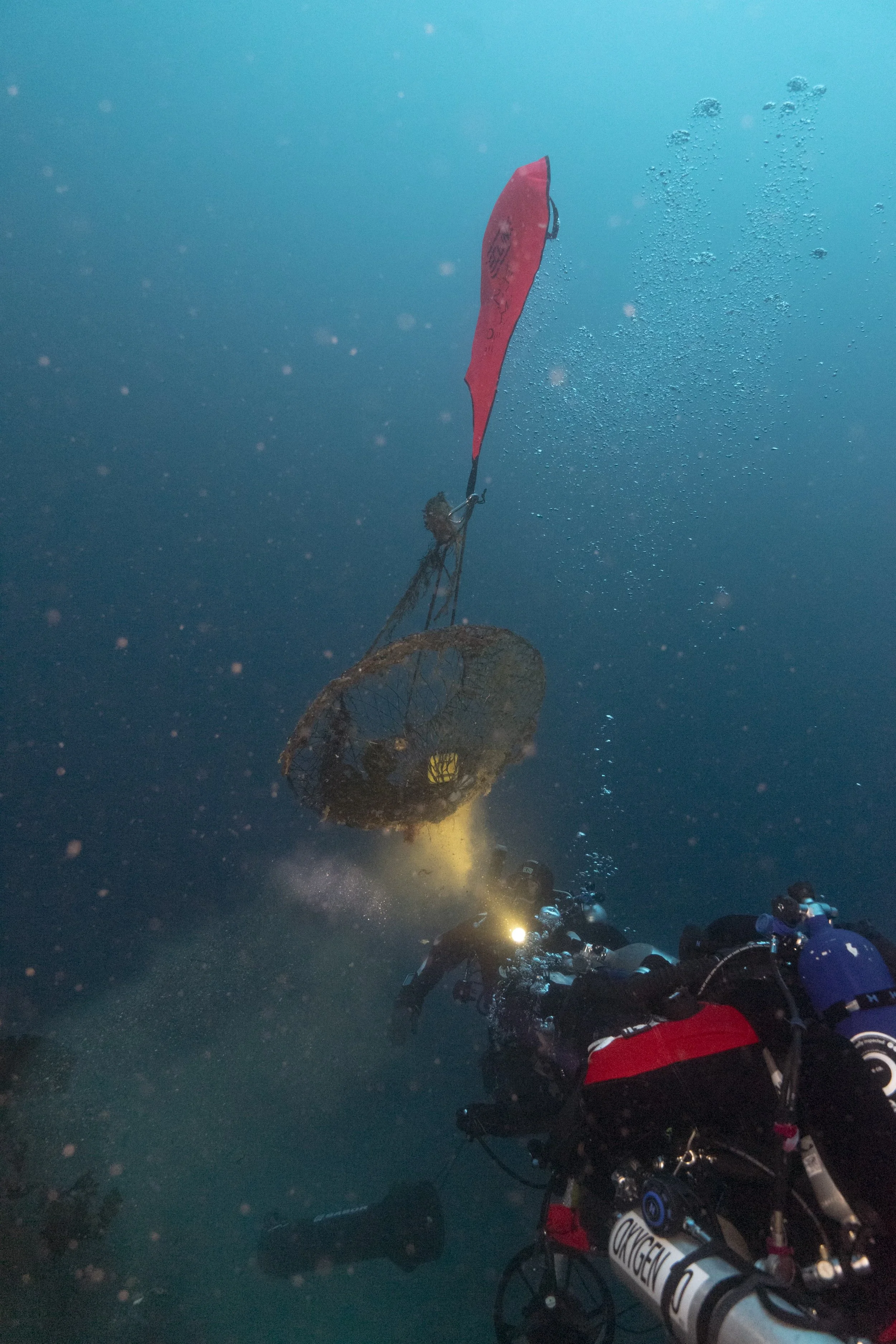



Tuna Clipper
Location: Santa Catalina Island
Wreck: The San Vito aka the Tuna Clipper
Net Handling Team 1: Jim Babor and Karim Hamza
Net Handling Team 2: Tianyi Lu and Nir Maimon
Documentation Team: Simeon Delikaris Manias and Mark Self
Team Ghost Diving USA returned to the Tuna Clipper on May 29th. There were multiple objectives for this mission. The first, to collect the rest of the net needed for the Beam Center playground equipment project. Next, recover a lift bag left behind on the last trip to the Tuna Clipper. Net handling team 1, Jim and Karim, were focused on the outer edge of the wreck where there is a significant amount of net buried in the sand. Net handling team 2, Tianyi and Nir, were focusing on other portions of the net closure to the wreck.






Our team did face some challenges. 2 lift bags were attached and then ripped off the net once they were inflated. Tianyi and Nir found a section of net that was attached to a significant amount of chain. The problem with this chain is that, due to the weight, the lift bags struggle to lift the chain to the surface. The team will have to return to address the portions of net that are attached to chain.
Of particular interest, the team found a very grim reminder of why our work is important. Amongst the net, divers found a skull. It was later determined that the skull belonged to a dolphin. The team was able to document and recover the skull. Heal the Planet (2021) estimated that approximately 650,000 whales, dolphins, seals, and other marine animals die as a result of fishing gear. Sadly, the team was again visited by this reality.
Earth Day
Earth Day was a busy and exciting day for Team Ghost Diving USA. We had the opportunity to do community outreach at 2 events. The first at the Los Angeles County Water District Headquarters in Whittier, California. The other at Pasadena ScienceFest held at John Muir High School in Pasadena, California. Both events were open to the public and anticipated around 2,000 attendees each.
Both events provided hands on learning activities for kids and educational materials related to our cause. Both teams enjoyed providing demonstrations of lift bag inflation and allowing people to try on recreational dive gear.
While we all love to get underwater and remove marine debris, we also love an opportunity to connect with the community and have conversations about why protecting the ocean is important.
The most frequently asked questions were about how people could get involved in our work. For those curious, there are a few ways:
Tell people about us. Share our social media channels, our website information, and our story. Scuba divers have the unique experience of seeing what is happening below the surface of the water. Without seeing the impact of abandoned fishing gear, it can be hard to understand the magnitude of the problem. This is why documentation is at the heart of our work. Through documentation, we can provide the evidence of the negative impact of marine debris and the positive results of our work.
Make sustainable choices. Choose products that are not single use, recycle, practice environmental mindfulness. While convenience can make life easier in the moment, it can have a lasting impact. Single use plastics, as an example, are non-biodegradable. This means that they become litter or sit in a landfill and pollute our environment. Choosing to use a reusable water bottle or reusable straws, for example, can help to reduce single use waste.
Be an informed consumer. Being an informed consumer allows you to make choices that reduce waste, conserve energy, avoid harmful substances, support sustainable practices, promote responsible waste management, and have a positive influence on the environment.
Whittier Team: Jim Babor, Norbert Lee, Curtis Wolfslau and Healthy Seas volunteers, Alisa and Julie.
Pasadena Team: Alex Caillat, Karim Hamza and Katie McWilliams.
The Jenny Lynne
Location: Rancho Palos Verdes Peninsula near Terranea Resort, California
Wreck: The Jenny Lynne
Net Handling Team 1: Jim Babor & Karim Hamza
Net Handling Team 2: Norbert Lee & Shane McWilliams
Documentation Team: Daniel Pio
Surface Support: Alex Caillat
Survey Team: Jim Babor, Karim Hamza, Shane McWilliams, Daniel Pio, Yury Velikanau, David Watson
The Jenny Lynne, pictured above, was a 66 feet long, 21.6 feet wide, 106 gross ton steel hulled fishing vessel built in 1972. On December 6, 2003, she was fishing for sardines and, for unknown reasons, starting taking on water. The crew was rescued by a local vessel, the San Pedro Pride. The Jenny Lynne came to rest in 150 feet of sea water with the highest point of the wreck sitting at 135 feet.
A survey the previous month found that there was a good amount of net on the bow, midship and on the seafloor around the wreck. The Ghost Diving USA documentation team took several images to facilitate the planning of the mission. Net Handling Team 1, Jim and Karim, worked on the midship section of the wreck and Net Handling Team 2, Norbert, Shane and Daniel, worked on the bow section of the wreck. Both teams successfully recovered a significant amount of net. Overall, a successful mission for team Ghost Diving USA!







Tuna Clipper
Location: Santa Catalina Island
Wreck: The San Vito aka the Tuna Clipper
Net Handling Team: Jim Babor and Karim Hamza
Documentation Team: Symeon Delikaris Manias and Curtis Wolfslau
Support Team: Mark Self
Ghost Diving USA continues their pursuit of ghost nets on the Tuna Clipper. On February 13, divers set out aboard the Giant Stride to collect more net for the Beam Center playground project. Conditions were less than generous to the team. The surface conditions were very rough, making the crossing to and from the dive site less than ideal. However, the team focused on the positives. They took a moment to celebrate Valentine’s Day with an early morning chocolate and got to work. The team deployed 4 lift bags which created a curtain of net. As the net handling team (Jim and Karim) was cutting through the net, it started to rise. Unfortunately, the lift bags ripped free of the net causing the net to fall back down. The teams persisted and were able to get one lift bag with net attached to the surface. The team ran out of bottom time and could not raise the final lift bag.
They completed the team completed their decompression along the slope of Catalina Island and enjoyed a little time on their scooters. When they got back to the boat, Captain Jim and Emma had collected the lift bags and net. Not every mission can go according to plan and conditions will not always be ideal. Team Ghost Diving USA is up for the challenge and looks forward to their next visit to the Tuna Clipper.
Tuna Clipper
Location: Santa Catalina Island
Date: January 28, 2023
Wreck: The San Vito aka the Tuna Clipper
Net Handling Team: Jim Babor and Karim Hamza
Documentation Team: Tianyi Liu
Support Team: Symeon Delikaris Manias
Team Ghost Diving USA set out on January 28th aboard the Giant Stride. Their goal was to start removing net off of the wreck of the San Vito aka the Tuna Clipper. The San Vito is an 85 foot vessel used to commercial tuna fishing out of San Pedro Harbor (L.A. Times Archives, 1985). The vessel crashed into some rocks due to poor visibility, capsized and ultimately sank at 12:30 am (L.A. Times Archives, 1985). The 12 crew members survived the incident by waiting for rescue in a small rowboat (L.A. Times Archives, 1985). The Tuna Clipper now rests in approximately 170 feet of water.
The Tuna Clipper wreck has been on the Ghost Diving team’s radar for a while. A few years ago, a documentation dive was completed. Photos and video were taken and showed that the wreck was covered in net. Jim estimates it will take approximately 2 years to clear the wreck of net. The team had a 2.5 hour boat ride to the wreck allowing the team to review the video from the original survey mission. They devised their plan, executed it and were well rewarded. They collected hundreds of pounds of net.
The net was recovered in 3 sections. The net will be sent to our partners for cleaning. One section will be sent to the Beam Center and pieces of the other 2 sections will be sent to artists who have requested it for their projects.







